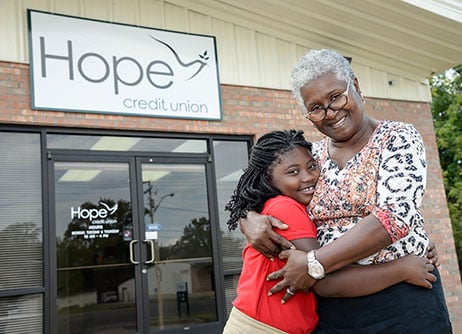Image

Bill Bynum, CEO, Hope Enterprise Corporation
Ed Sivak, Chief Policy and Communications Officer, Hope Enterprise Corporation
Challenge: Across the United States, there are 384 persistent-poverty counties where the poverty rate has exceeded 20 percent for three decades in a row. In many of these counties, banks have consolidated and closed their offices, choosing to operate in more profitable areas. As a result, residents must drive miles for basic services or, more likely, go unbanked. Losing this financial base makes it very difficult for residents to obtain loans for homes or small businesses.
Across the United States, there are 384 persistent-poverty counties where the poverty rate has exceeded 20 percent for three decades in a row. Fully one-quarter of the country’s persistent-poverty counties are located in the Mid-South states of Arkansas, Louisiana and Mississippi. A deeper demographic analysis clarifies that persistent poverty is particularly acute in the Black Belt counties of these states. In 35 of 39 Mid-South counties where the African American population exceeds 50 percent, the poverty rate has been above 20 percent for the last 30 years. These counties are also home to some of the highest rates of unemployment and unbanked / underbanked households in the region. The intersection of poverty, race, employment and access to affordable financial services underscored the need for lasting community development solutions.
In 2015, Regions Bank announced plans to consolidate its operations in the Mississippi Delta and close its branches in the communities of Itta Bena and Moorhead. Both towns are located in persistent-poverty counties with populations of just over 2,000 residents – 9 out of 10 of whom are African American. In the absence of an alternative bank, local people would face the grim prospect of having to drive miles for basic banking services.
Building on their longstanding relationship, Hope Enterprise Corporation / Hope Credit Union (HOPE) and Regions Bank worked together to develop a solution. Regions donated its facilities to HOPE, provide information about HOPE to its customers, and allowed HOPE to set up an in-branch presence to market the credit union’s products and services. Finally, the bank also provided grant funding to support HOPE’s start-up costs.
In November 2015, the former Regions locations re-opened as HOPE branches. Almost immediately, HOPE’s local team members, a number of whom formerly worked for the bank, saw that things had changed.
 First, HOPE was lending in the communities. In the years leading up to the transition, neither the Itta Bena nor the Moorhead branches originated loans. Bank customers were required to drive to branches in larger cities to apply for a loan. Second, HOPE reviewed loan applications through its community development lens. If a member was not ready for a loan, then someone from the HOPE team would sit down with the member to help them develop a plan to achieve their goals. Third, HOPE installed ATMs at both locations, where previously there had been none, to ensure that members and residents of the community could access cash even when the credit union was closed.
First, HOPE was lending in the communities. In the years leading up to the transition, neither the Itta Bena nor the Moorhead branches originated loans. Bank customers were required to drive to branches in larger cities to apply for a loan. Second, HOPE reviewed loan applications through its community development lens. If a member was not ready for a loan, then someone from the HOPE team would sit down with the member to help them develop a plan to achieve their goals. Third, HOPE installed ATMs at both locations, where previously there had been none, to ensure that members and residents of the community could access cash even when the credit union was closed.Johnnie Lee Murry’s story underscores the dramatic change experienced in one of the communities. Shortly after HOPE’s Itta Bena branch opened, Murry applied for an auto loan. Due to some past credit challenges, however, he did not immediately qualify. Rather than turn Murry away, HOPE’s team sat down with him and developed a plan to improve his credit.
Murry took out a small-dollar loan in which half was set aside as a savings account. Over the life of the loan, he never missed a payment. After paying off the loan, his credit score went up and he was approved for the auto loan. Today, he is driving a new, reliable vehicle.
Murry is not alone. In the first eight months of operations, over 1,100 people have opened accounts with HOPE in its two new locations. The credit union also has originated $200,000 in loans. It will replicate this strategy in 2016 in two other rural Mississippi communities with persistent poverty and limited banking options.
Three important lessons emerge from HOPE’s expansion in the Mississippi Delta. First, after a job, the single most important financial relationship an individual can have is the one with a financial institution. When one’s financial relationship is with a depository, the path to ownership, for an automobile, a home or a small business for example, is much more direct than if that relationship doesn’t exist or exists only with a high cost alternative.
Second, relationships matter and meaningful partnerships facilitate the deepest impacts. Bank and credit union partnerships are rare. However, the teams at HOPE and Regions had a long history of working together. The trust and social capital built up over the years between the institutions contributed to an environment of shared goals.
Finally, policy matters. All four of the branches were located in areas that were sensitive to Community Reinvestment Act (CRA) requirements by the bank. Undoubtedly, the CRA served as a catalyst for these innovative transactions illustrating that good policy broadens the reach of effective organizations.

